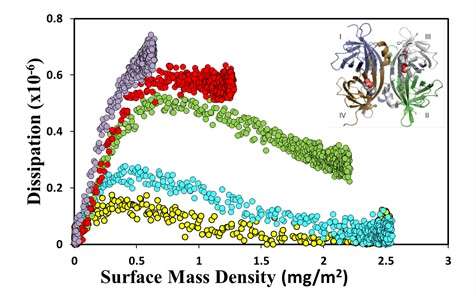Reference biosensor developed for calibrating diagnostic devices

Researchers at the National Physical Laboratory (NPL), in collaboration with Chalmers University of Technology, Sweden, and the University of Tampere, Finland, have developed a novel reference biosensor to aid the development of calibrated and standardised diagnostic devices. The main intention of this work is to have a reproducible system that could be used to normalise and compare data and test new diagnostic devices to validate claims concerning sensitivity and detection limits.
Many diagnostic tests rely on the rapid and accurate measurement of biomolecule concentration. For example, increased levels of the protein troponin in the blood is a strong indicator that a patient has suffered heart damage and can therefore be used to diagnose heart attacks. Biosensors are a type of diagnostic test that detect the presence of biomolecules, such as troponin. But until now, standards to ensure the accuracy of measurements using biosensors have been lacking.
The team from NPL, Chalmers University of Technology and the University of Tampere have developed a novel reference biosensor described in a publication in the journal Langmuir, based upon well-understood thiols conjugated to biotin.
Because of their selective and stable interaction, avidin and biotin are commonly used to demonstrate the performance of new biosensors, making them an obvious choice for the reference sensor. These molecules can be attached in a controllable and reproducible manner to a gold surface, which is convenient because many techniques rely upon noble metal surfaces for their operation, while the biotin is able to capture avidin and streptavidin proteins from solution.
The biosensor developed in this work produced very stable, highly repeatable and reproducible results, making it ideal for use as a reference sensor against which other sensors can be compared. These reference sensors can be used to calibrate and compare the performance of different biosensors, to reliably assess the accuracy of the measurements they make and encourage the development of new diagnostic technologies.
The new sensor is also capable of determining the type of bond formed between the biotin and avidin (i.e. whether the avidin has attached to one or two biotin molecules), a feature which was not previously distinguishable, although the practical applications of this have yet to be discovered.
More information: "Neutralized Chimeric Avidin Binding at a Reference Biosensor Surface" Langmuir, 2015, 31 (6), pp 1921–1930 DOI: 10.1021/la503213f
Journal information: Langmuir
Provided by National Physical Laboratory
















